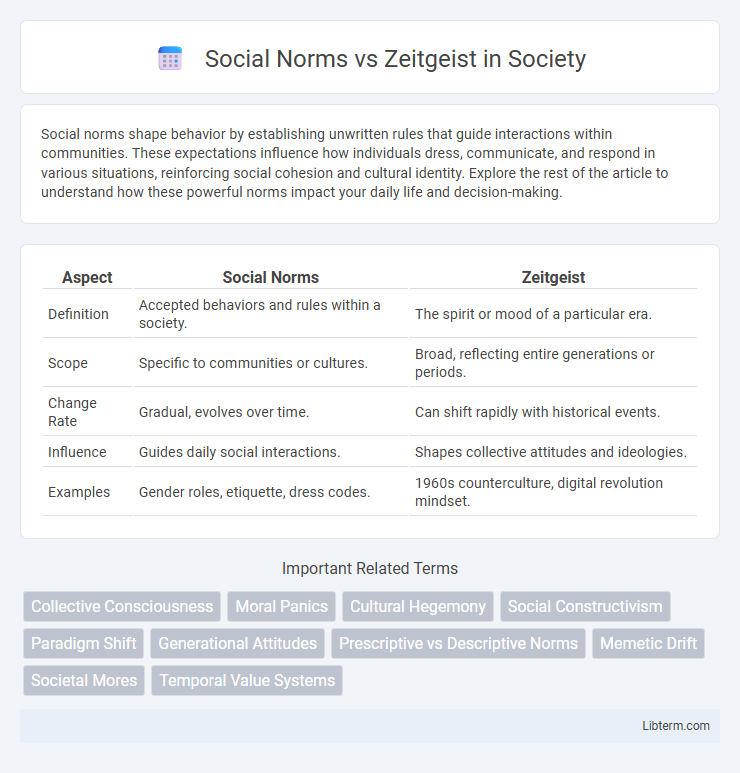Social norms shape behavior by establishing unwritten rules that guide interactions within communities. These expectations influence how individuals dress, communicate, and respond in various situations, reinforcing social cohesion and cultural identity. Explore the rest of the article to understand how these powerful norms impact your daily life and decision-making.
Table of Comparison
| Aspect | Social Norms | Zeitgeist |
|---|---|---|
| Definition | Accepted behaviors and rules within a society. | The spirit or mood of a particular era. |
| Scope | Specific to communities or cultures. | Broad, reflecting entire generations or periods. |
| Change Rate | Gradual, evolves over time. | Can shift rapidly with historical events. |
| Influence | Guides daily social interactions. | Shapes collective attitudes and ideologies. |
| Examples | Gender roles, etiquette, dress codes. | 1960s counterculture, digital revolution mindset. |
Defining Social Norms: Foundations of Collective Behavior
Social norms represent the unwritten rules and shared expectations that govern individual behavior within a community, shaping collective actions and social cohesion. These norms arise from repeated interactions and cultural traditions, providing a framework for acceptable conduct and enabling social predictability. Distinct from the zeitgeist, which reflects the broader spirit or mood of a historical period, social norms establish the foundational criteria for everyday behavior and group conformity.
Understanding Zeitgeist: The Spirit of the Times
Zeitgeist represents the collective mindset, cultural mood, and intellectual climate that define a particular era, shaping societal values, behaviors, and trends. Unlike social norms, which are explicit rules governing behavior within a community, zeitgeist reflects the deeper, often unspoken spirit influencing how societies interpret events and innovations. Understanding zeitgeist is crucial for analyzing historical shifts, predicting cultural evolution, and grasping the underlying forces driving changes in art, politics, and social movements.
Historical Evolution of Social Norms
The historical evolution of social norms reveals patterns of collective behavior shaped by cultural, economic, and political changes over centuries, illustrating how societies codify expectations to regulate individual actions. Shifts in prevailing social norms often correspond to underlying transformations in the zeitgeist, reflecting dominant values and ideologies of specific historical periods such as the Enlightenment or the Industrial Revolution. This dynamic interplay highlights that while social norms anchor stability, they also adapt in response to emerging social consciousness and evolving collective experiences.
Zeitgeist's Influence on Societal Attitudes
Zeitgeist represents the prevailing cultural, intellectual, and moral climate of an era, significantly shaping societal attitudes by influencing collective beliefs and values. This cultural spirit drives shifts in public opinion and behavior patterns, often dictating the acceptance or rejection of social norms within a community. The dynamic interaction between zeitgeist and social norms leads to the evolution of societal standards, reflecting the changing priorities and consciousness of the population.
How Social Norms and Zeitgeist Interact
Social norms and zeitgeist interact dynamically as social norms represent shared expectations of behavior within a society, while zeitgeist embodies the prevailing cultural, intellectual, and moral climate of a specific era. Changes in zeitgeist often drive the evolution of social norms by influencing collective values and attitudes, leading to shifts in what behaviors are deemed acceptable. Conversely, established social norms can reinforce or challenge aspects of the zeitgeist, creating a feedback loop that shapes societal progress and cultural identity.
Case Studies: Moments When Zeitgeist Challenged Norms
The 1960s civil rights movement exemplifies when zeitgeist challenged entrenched social norms by demanding racial equality and justice, reshaping societal values across the United States. Similarly, the #MeToo movement shifted the cultural climate by confronting long-standing norms about sexual harassment and gender power dynamics globally. These case studies highlight how prevailing cultural spirits can disrupt and redefine social conventions, accelerating progress and transformation.
Social Change: From Norms to New Zeitgeists
Social change often begins with a shift in social norms, as collective behaviors and attitudes evolve to challenge existing practices. These evolving norms gradually influence the broader cultural zeitgeist, reflecting new values and priorities within society. Over time, the interplay between changing social norms and emerging zeitgeists can lead to transformative societal progress and redefined cultural identities.
The Role of Media in Shaping Zeitgeist and Norms
Media platforms significantly influence the zeitgeist by amplifying prevailing attitudes and highlighting emerging cultural trends that mold public perception. Through selective framing and repeated exposure, media shapes social norms by defining what behaviors are acceptable and desirable within society. This dynamic interaction between media-driven narratives and collective consciousness accelerates shifts in societal values and reinforces dominant ideologies.
Generational Perspectives on Social Norms vs Zeitgeist
Generational perspectives on social norms versus zeitgeist reveal how established conventions often contrast with the dominant cultural spirit of the time. Older generations tend to uphold traditional social norms as guiding principles, while younger cohorts embrace the zeitgeist, reflecting contemporary values and rapid societal changes. This dynamic interplay shapes evolving attitudes toward issues like gender roles, technology adoption, and environmental awareness.
Navigating the Future: Adapting to Shifting Social Currents
Navigating the future requires understanding the dynamic interplay between enduring social norms and the evolving zeitgeist that shapes collective attitudes. Adapting to shifting social currents involves recognizing the influence of cultural values, technological advancements, and generational perspectives that redefine acceptable behavior. Successful adaptation hinges on balancing respect for established practices with openness to innovative ideas that reflect contemporary societal trends.
Social Norms Infographic

 libterm.com
libterm.com